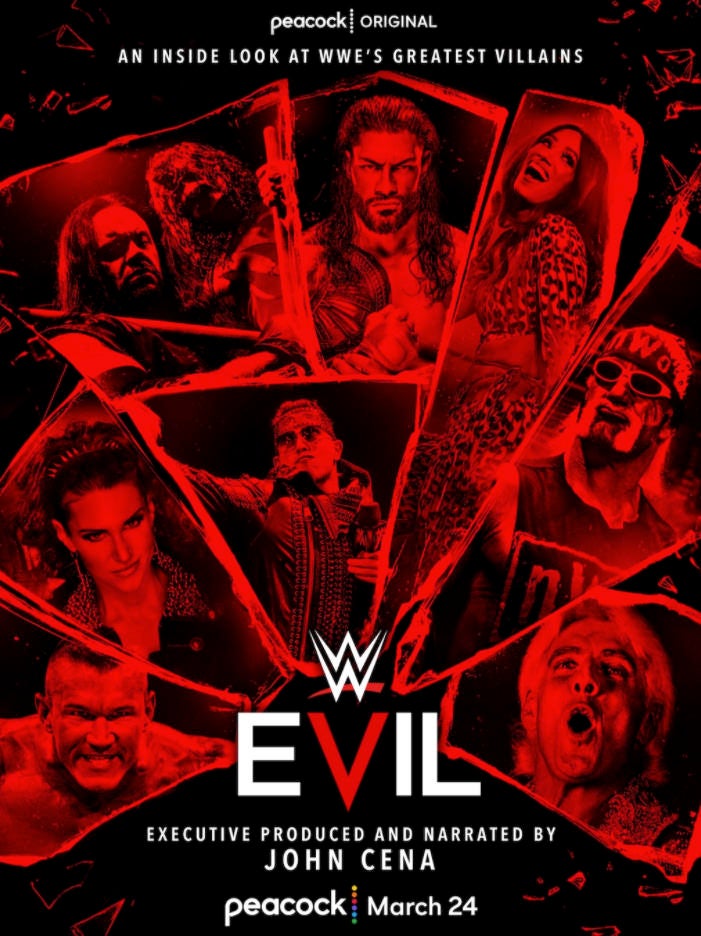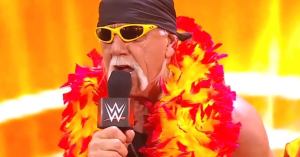WWE Evil is the first original series from WWE and Peacock’s partnership, and as the title suggests, some of WWE’s biggest villains are in the spotlight. Over the course of eight episodes, names like Hulk Hogan, Sasha Banks, Randy Orton, The Miz, Stephanie McMahon, The Undertaker and Kane, and Ric Flair are all put under the microscope, as narrator John Cena maps out their journey from WWE superstars to the ultimate villains they would become. Each episode dives into their industry origins and how they were shaped into the bad guys we adore, but the episodes that reach a bit further to reveal the people behind the characters and storylines are when WWE Evil truly succeeds, and while the vulnerability varies by episode, more often than not I couldn’t help but come away with a newfound appreciation for some of my favorite superstars, and that can’t be called anything but a success.
Videos by ComicBook.com
WWE Evil leads off with three of its strongest episodes, beginning with Hulk Hollywood Hogan. Out of all of the stories featured in WWE Evil, Hogan’s is undoubtedly the most well-known and most explored, with any number of documentaries recalling the Monday Night Wars and the battle between WWE and WCW. That is in part why I wasn’t exactly expecting much in the way of new ground, but that was pleasantly not the case. WWE Evil isn’t afraid to move past the heyday of the NWO to focus on the fall of WCW and Hogan’s own part in that collapse, drawing out some welcome and unexpected vulnerability from Hogan, Eric Bischoff, and more on the subject.

The Miz follows next in what ends up being one of the most insightful episodes of the series. From the introduction of The Miz on The Real World to his days of being hazed by the locker room all the way to his seat atop the A-List, fans will the arc of their journey both outside of and within WWE, though finding the person underneath the A-List facade is what stands out most. This is quite prevalent with Miz, as by episode’s end you’ll have a much more thorough understanding of how Mike transformed into the Miz and why he felt the need to create the character in the first place, as Miz acted as a shield in some ways to those who disliked him even before he got to WWE.
Meanwhile, Sasha Banks’ episode explores the origins of her villainous character while also revealing how getting too lost in that character can take its toll over time. The same can be said for Randy Orton’s episode, which presents the star’s early days and his battles with ego and guilt as he made his way to the eventual superstar he is today. The stories of Banks and Orton’s rise to superstardom are well documented and the series does go over those established beats as well, but the team has done a stellar job of showcasing behind-the-scenes footage and small details to complement those well-established aspects of their stories to keep fans intrigued.
This is true of the series’ fantastic finale spotlight on Roman Reigns, which documents his early football days and the step by step transformation into the Tribal Chief powerhouse we all know today, but again, it’s the vulnerable moments in-between that really stay with you after the episode reaches its conclusion. Reigns may be the focal point, but it’s the glimpses of Joe that are most compelling. Whether it’s his reaction to being booed after his battle with cancer or the light shed by the Usos on Joe’s natural affinity for being a heel, it’s endlessly fascinating.
There’s not a bad episode in the collection from the ones I’ve seen (Ric Flair’s episode was not included in the initial batch of screeners), though Brothers of Destruction and Stephanie McMahon’s episodes were the two weaker ones. Not that their stories in and of themselves are any less compelling mind you, but their episodes keep far more focus on the characters they play and storylines they’ve been a part of, and there isn’t much room to get to know who they are behind it all. New concept art and behind-the-scenes footage add new elements to keep things fresh, but it’s more difficult to form that personal connection, something the other episodes establish early on.
WWE Evil is the perfect introduction to some of WWE’s biggest superstars, though longtime fans will also enjoy the brief but genuine glimpses into the people that have brought these characters to life for so long, meaning no fan should miss out on what WWE Evil has to offer.
Rating: 4.5 out of 5
WWE Evil is now available to stream on Peacock.
What did you think of WWE Evil? Let us know in the comments or as always you can talk all things wrestling with me on Twitter @MattAguilarCB!





